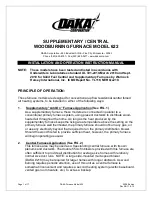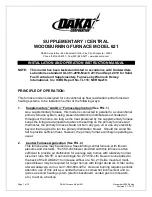
507712-01
Page 23 of 36
Issue 1642
Accessory Terminals
One line voltage “EAC” 1/4” spade terminal is provided on
the furnace integrated control. See Figure 26 for integrated
control configuration. This terminal is energized when the
indoor blower is operating. Any accessory rated up to one
amp can be connected to this terminal with the neutral
leg of the circuit being connected to one of the provided
neutral terminals. If an accessory rated at greater than one
amp is connected to this terminal, it is necessary to use an
external relay.
One line voltage “HUM” 1/4” spade terminal is provided
on the furnace integrated control. See Figure 26 for
integrated control configuration. This terminal is energized
in the heating mode when the combustion air inducer is
operating. Any humidifier rated up to one amp can be
connected to this terminal with the neutral leg of the circuit
being connected to one of the provided neutral terminals. If
a humidifier rated at greater than one amp is connected to
this terminal, it is necessary to use an external relay.
Generator Use - Voltage Requirements
The following requirements must be kept in mind when
specifying a generator for use with this equipment:
• The furnace requires 120 volts ± 10% (Range: 108
volts to 132 volts).
• The furnace operates at 60 Hz ± 5% (Range: 57 Hz
to 63 Hz).
• The furnace integrated control requires both polarity
and proper ground. Both polarity and proper grounding
should be checked before attempting to operate the
furnace on either permanent or temporary power.
• Generator should have a wave form distortion of less
than 5% RHO.
Thermostat
Install the room thermostat according to the instructions
provided with the thermostat. See Figure 23 for thermostat
designations. If the furnace is being matched with a
heat pump, refer to the FM21 installation instruction or
appropriate dual fuel thermostat instructions.
*
Note
: “R” Required on some outdoor units.
Figure 23. Condensing Unit Thermostat Designations
Indoor Blower Speeds
1. When the thermostat is set to “FAN ON,” the indoor
blower will run continuously on the heating speed
when there is no cooling or heating demand.
2. When the unit is running in the heating mode, the
indoor blower will run on the heating speed.
3. When there is a cooling demand, the indoor blower will
run on the cooling speed.













































